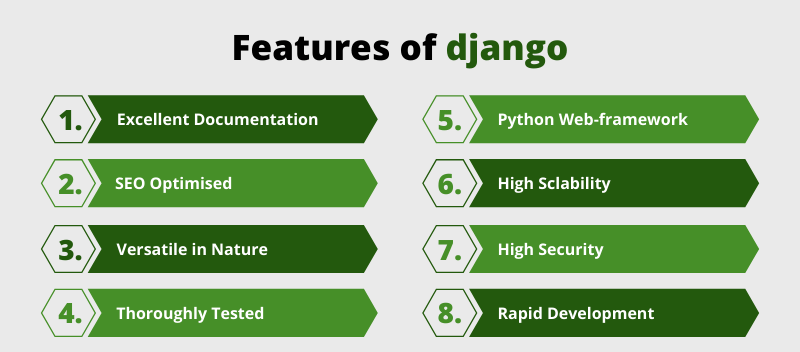Django framework
Django is a high-level web framework for building web applications in Python. It was created in 2003 and is maintained by the Django Software Foundation. Django is designed to help developers build web applications quickly and with less code, using a clean and pragmatic design.
Some of the key features of Django includes:

- Object-relational mapper (ORM): Django’s ORM provides a way to interact with databases using Python code, without having to write SQL queries directly.
URL routing: Django provides a way to map URLs to view functions or classes, making it easy to create a modular and flexible URL structure. - Templating engine: Django’s built-in templating engine makes it easy to separate presentation logic from business logic, and provides a convenient way to generate HTML dynamically.
Admin interface: Django provides a powerful and customizable admin interface for managing application data, which can be easily extended to meet specific requirements. - Security features: Django includes built-in protection against common security issues such as cross-site scripting (XSS) and cross-site request forgery (CSRF).
Scalability: Django is designed to handle high-traffic sites and can be easily scaled horizontally or vertically as needed. - URL Routing: Django has a built-in URL routing system that maps URLs to views. This makes it easy to organize your application’s URLs and handle requests.
- Admin Interface: Django comes with a built-in admin interface that allows developers to manage the application’s data with ease. It is highly customizable and can be extended to meet specific requirements.
- Internationalization and Localization: Django supports internationalization and localization out of the box. It makes it easy to translate your application’s content into multiple languages.
- Scalability: Django is highly scalable and can handle high-traffic sites. It supports horizontal and vertical scaling and can be used to build applications of any size.
Overall, Django is a powerful and flexible web framework that makes it easy to build web applications quickly and efficiently.
A comparison between django and nodejs
Django and Node.js are two popular web development frameworks with different strengths and use cases. Here are some key differences between the two:
Language: Django is written in Python, while Node.js is written in JavaScript. This means that developers who are already familiar with either language may find it easier to learn and work with the corresponding framework.
Architecture: Django is a server-side web framework, while Node.js is a runtime environment that allows developers to build both server-side and client-side applications. This means that Node.js may be a better choice for developers who want to build real-time, event-driven applications that require frequent updates and high concurrency.
Database Support: Django has a built-in ORM that supports multiple databases, including MySQL, PostgreSQL, SQLite, and Oracle. Node.js has several database drivers available, but it doesn’t have a built-in ORM. This means that developers may need to write more database-specific code when using Node.js.
Ecosystem: Django has a large and mature ecosystem of third-party packages and plugins, making it easy to add features and functionality to your application. Node.js also has a large ecosystem, but it can be more fragmented due to the wide range of use cases it supports.
Learning Curve: Django has a steeper learning curve than Node.js due to its emphasis on convention over configuration and its use of Python, which may be more complex for beginners. Node.js is generally easier to learn, especially for developers with prior experience in JavaScript.
Overall, the choice between Django and Node.js depends on the specific requirements and constraints of your project. Django is a great choice for building complex, data-driven web applications, while Node.js may be better suited for real-time, event-driven applications that require high concurrency.
Steps to setup django application
Here are the general steps to set up a Django application:
Install Python: Django is a Python web framework, so you’ll need to install Python on your computer. You can download the latest version of Python from the official website (https://www.python.org/downloads/).
Install Django: You can install Django using pip, which is the package installer for Python. Open a command prompt or terminal window and run the following command:
pip install Django
This will install the latest version of Django.
Create a Django project: To create a new Django project, run the following command in the command prompt or terminal window:
django-admin startproject project_name
Replace “project_name” with the name of your project. This will create a new directory with the same name as your project, containing the basic files and directories needed to get started.
Run the development server: Change to the project directory and run the following command to start the development server:
python manage.py runserver
This will start the development server on the default port (8000). You can now open your web browser and go to http://localhost:8000/ to see the default Django welcome page.
Create a new app: A Django project can contain multiple apps, each with its own set of models, views, and templates. To create a new app, run the following command in the project directory:
python manage.py startapp app_name
Replace “app_name” with the name of your app. This will create a new directory with the same name as your app, containing the basic files and directories needed to get started.
Configure the database: By default, Django uses a SQLite database for development. You can configure the database settings in the project’s settings.py file to use a different database, such as MySQL or PostgreSQL.
These are the basic steps to set up a Django application. From here, you can start building your models, views, and templates to create your web application.
Sample output:

